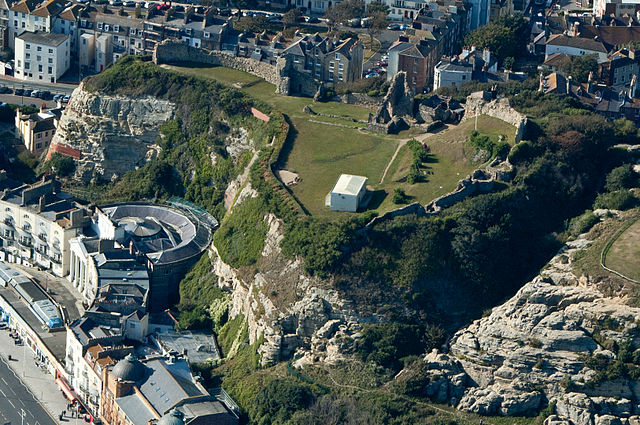One of the scenes in the Bayeux Tapestry shows the building of Hastings Castle. Originally it was constructed quickly, using wood, even before Duke William defeated King Harold at the Battle of Hastings on October 14 1066. Thus, it was one of the first Norman castles, along with Dover, and the prefabricated Pevensey, which was brought over in ‘kit form,’ in 1,000 barrels, and put together in the remains of the Roman fort at Anderitum (Pevensey.)
In about 1068, Hastings Castle and the land around it were awarded to Robert, Count of Eu, who had commanded 60 of the ships in the Norman invasion fleet. The area was originally granted to Onfray du Tilleul, who died in 1068, and was another of Duke William’s trusted supporters.
William, doubtless still somewhat insecure in his rule, gave orders in 1070 that Hastings was to be rebuilt using stone, along with the adjacent chapel of St. Mary. Mediaeval priests claimed that St. Mary’s was founded by King Edward the Confessor, and certainly, architectural evidence does indicate that it was older than the castle. Count Robert seems to have founded the College of Priests at St. Mary’s in 1090. In 1094, King William II stayed at the castle. During the reign of King Henry II (1154-1189) the castle fortifications were strengthened. Was it perhaps because he feared a rebellion, after seemingly calling for the death of Archbishop Thomas Becket of Canterbury in December 1170?
By 1216, King John seems to have direct control of the castle, when he ordered that it and Pevensey were to be slighted – that is destroyed. This is at the time when Dauphin Louis of France invaded England, during the first barons’ war, when the barons opposed King John and planned to overthrow him and install a French king. Destroying the castles would deny the invaders their use. The dauphin landed on the Isle of Thanet with a fleet of some 700 ships. The support of local landowners meant that Louis soon controlled a large part of the south-east and even reached London unhindered. Here, the barons proclaimed him king of England. By the summer of 1216 he had captured the important city of Winchester and controlled about half of the country. When he was in Dover, King Alexander of Scotland visited, to pay homage to him.
The tide turned when King John died of dysentery, and his nine year old son took the throne as King Henry III. He was crowned on October 28. John’s death had ended the grievances that the barons had with the crown and eventually Louis lost their support. This culminated in the Battle of Sandwich, a sea battle, in the summer of 1217, in which the French were heavily defeated. On 11th September, Louis signed the Treaty of Kingston, in which he gave up his claim to the crown of England.
In 1220, King Henry III ordered that Hastings Castle be restored to a usable condition, to enable it to play its part in defending the south coast from French raids. The family of the Count of Eu gave up ownership when Count William decided that he preferred his family’s French possessions to their English estate, so he was legally disinherited. In 1242 the king passed ownership to Count Peter of Savoy, an uncle of his wife, Eleanor of Provence. Count Peter died in 1268.
February 1287 was a season of violent storms. Such was their overwhelming strength that the sandstone cliffs, including that on which Hastings Castle stood, collapsed, along with part of the castle. Then, in 1339 and 1377, Hastings was attacked by the French and many buildings were destroyed by fire. These man-made disasters were followed by more of the natural kind, with more erosion leading to more of the castle collapsing into the sea.
The castle and surrounding areas were then used for farming by the Pelham family, after Thomas Pelham bought them on June 23 1591. The remains of the castle became so overgrown with shrubs and rampant weeds that they were soon forgotten about. When the Earl of Chichester, a Pelham descendant, was building Pelham Place during 1824-5, he instigated some archaeological digging at the site of the castle. This led to some parts of the chapel being reconstructed from fallen stones.
More damage was done to the castle, this time by German bombs when Hastings was targeted during the second world war. The borough council bought the castle ruins in 1951, and after renovation they became a popular tourist attraction.
Image Credits: Barbara van Cleve https://commons.wikimedia.org/wiki/File:Hastings_Castle.jpg Creative Commons Attribution-Share Alike 4.0 International https://creativecommons.org/licenses/by-sa/4.0/deed.en.



